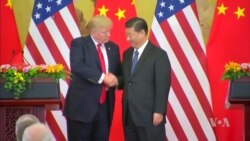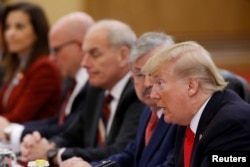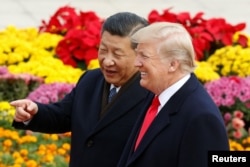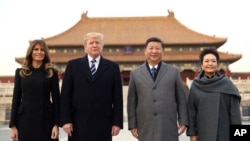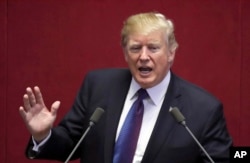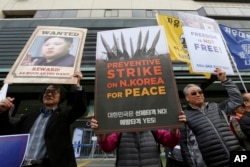U.S. President Donald Trump on Thursday said the United States and China must work together to liberate the region and the world from what he called the very serious threat posed by the “murderous regime in North Korea.
Trump made the comment as he stood alongside Chinese President Xi Jinping as they delivered successive prepared remarks, but did not take questions from journalists.
Trump added that Washington and Beijing agreed “not to repeat the mistakes of the past” in dealing with Pyongyang, which over the years has managed to rapidly advance its nuclear weapons and ballistic missile programs.
Trump earlier said excellent progress was made in his talks with Xi.
“The entire civilized world must unite to confront the North Korean menace,” he added.
Secretary of State Rex Tillerson, who is accompanying the president, told reporters after the meetings that the Chinese, have been clear and unequivocal over the two days of talks that they will not accept a North Korea with nuclear weapons.
“There’s no space between both of our objectives,” said Tillerson. “We have our own views of the tactics, the timing and how far to go with pressure and that’s what we spend a lot of time exchanging views on.”
Trump, according to Tillerson, told Xi: “You’re a strong man, I’m sure you can solve this for me.”
In his prepared remarks, Xi’s tone was more muted regarding North Korea, saying, “We reiterated the firm commitment to denuclearize the peninsula.”
“I believe there is a solution to that, as you do,” Trump told Xi during an extended bilateral meeting Thursday morning in the Chinese capital.
Later, while he and Xi spoke to a meeting of business leaders, Trump said, “I thank President Xi for his recent efforts to restrict trade with North Korea and cut off banking ties. China can fix this problem easily and quickly.”
Bilateral trade
The talks between Trump and Xi are also dealing with bilateral trade, a touchy subject because Trump has long complained about the trade imbalance between China and the United States.
For the first 10 months of the year, China’s trade surplus with the U.S. was $223 billion, according to recent data released by China’s General Administration of Customs.
Trump said the U.S. trade deficit with China is, “shockingly hundreds of billions of dollars” annually. “Past administrations allowed it to get so far out of kilter. But I don’t blame China. I give China great credit,” Trump said.
President Xi said there is a wider and prosperous future for U.S.-China cooperation on trade, adding that $250 billion worth of business deals were signed during President Trump’s visit to China and that, “Chinese investment in the United States is rising rapidly.”
But the roughly 15 agreements unveiled in Beijing are mostly nonbinding memorandums of understanding and, according to Bloomberg News “could take years to materialize — if they do at all.”
Derek Scissors, a resident scholar at the American Enterprise Institute is pessimistic that such deals will do much to address the real hindrances to trade relations with China.
“The president likes deals, and he likes big numbers, but we’re not going to change something he doesn’t like, like the trade deficit, without changing Chinese trade practices,” Scissors said. “China has to have a different approach to trade in the world than it does.”
Scissors said that more than the deficit, it is what is behind the numbers, such as the fact that Chinese state owned enterprises never go out of business.
“Which means American goods and services can’t ever win in the China market,” he said.
In his joint statement, Xi said “there needs to be in-depth discussions on the trade imbalance” with the United States, among other issues.
The Chinese leader predicted “there will be a wider and prosperous future for cooperation on trade,” specifically mentioning the oil and gas sector, beer, agricultural products, education and service contracts. He also invited more American companies to participate in China’s “One Belt One Road” initiative, an effort to create the world’s largest platform for economic cooperation, inspired by the ancient Silk Road trading network.
The United States and China, respectively, have the world’s largest economies and most powerful militaries.
Welcome to Beijing
The two leaders walked side by side on a red carpet at a welcoming ceremony early Thursday at the Great Hall of the People in Beijing. The U.S. and Chinese national anthems were played by a military band and ceremonial cannon fire from Tiananmen Square saluted Trump. An exuberant crowd of schoolchildren waved U.S. and Chinese flags.
The Trump administration is showcasing several business deals signed during the China trip, including a deal for China’s biggest online retailer to buy $1.2 billion of American beef and pork.
U.S. Commerce Secretary Wilbur Ross has said such business deals “are a good example” of how the United States “can productively build up our bilateral trade.”
Trump also met Thursday with Chinese Premier Li Keqiang, whose position is similar to that of a prime minister.
Trump and his wife, Melania, were received with great pageantry on their arrival to China. The Trumps were also treated to a private visit to the Forbidden City, China’s ancient imperial palace. They also viewed an outdoor opera featuring costumes, music and martial arts.
South Korea
The U.S. president arrived in Beijing a day after delivering a speech in Seoul, South Korea, in which he called on other nations to unite and “isolate the brutal regime of North Korea.”
“You cannot support, you cannot supply, you cannot accept,” he added.
In that speech to South Korea’s National Assembly, Trump had a forceful message for Pyongyang. He called on leader Kim Jong Un to give up all of his nuclear weapons for a chance to step onto “a better path.”
Trump warned the North, “Do not underestimate us and do not try us. We will defend our common security, our shared prosperity and our sacred liberty.”
Backing the president’s words was the presence of three U.S. aircraft carrier strike groups and nuclear submarines, which the president said “are appropriately positioned” near the Korean Peninsula.
‘Total failure’
The U.S president referred to North Korea as “a total failure,” and a “twisted regime” ruled by a cult and a tyrant who enslaves his people, a characterization certain to provoke a harsh rhetorical reply from Pyongyang.
“The world cannot tolerate the menace of a rogue regime that threatens it with nuclear devastation,” said Trump in his speech. “All responsible nations must join forces to isolate the brutal regime of North Korea, to deny it any form of support.”
The U.S. leader had effusive praise for South Korea, contrasting its economic success with what he characterized as the “dark” situation in the North.
“The more successful South Korea becomes, the more decisively you discredit the dark fantasy at the heart of the Kim regime,” Trump said.
The speech ended on a hopeful note, which is the Korean dream: the peaceful reunification of the peninsula. But with Kim’s weapons of mass destruction posing a greater threat, Trump warned, “the longer we wait, the greater the danger grows and the few the options become.”
President Trump generally took a more optimistic view of diplomacy during his visit to Seoul, which included meetings with South Korean President Moon Jae-in. He said progress has been made to diffuse heightened tensions in the region, a striking departure from the tone of his tweets in recent weeks suggesting talks with Pyongyang to resolve the nuclear crisis were “a waste of time.”
VOA's Bill Ide and Marissa Melton contributed to this report.




